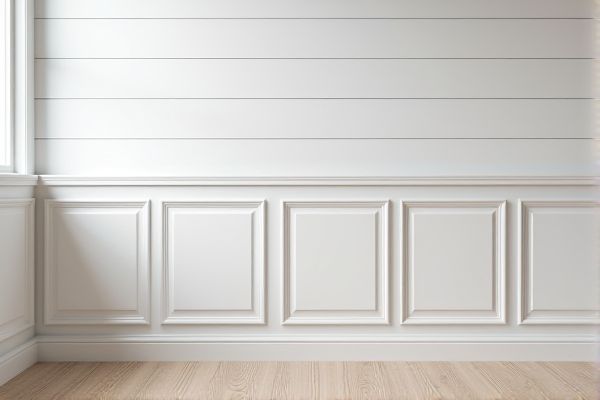
Shiplap walls offer a smooth, interlocking design with horizontal planks that create a sleek, modern aesthetic, while beadboard walls feature narrow, vertical panels with distinctive grooves for a classic, textured look. Explore the rest of the article to discover which option best suits your style and space needs.
Table of Comparison
| Feature | Shiplap Wall | Beadboard Wall |
|---|---|---|
| Material | Wood or MDF boards with rabbeted edges | Narrow, vertical wooden planks with a beaded groove |
| Appearance | Horizontal overlapping boards, clean lines | Vertical panels with decorative bead detailing |
| Installation | Boards overlap for a tight, angled fit | Panels fitted side-by-side, often with tongue-and-groove |
| Durability | Moderate; depends on wood type, good for moisture control | Durable; beads may collect dirt but add texture |
| Style | Modern farmhouse, rustic, coastal | Traditional, cottage, farmhouse |
| Maintenance | Easy to clean, occasional repainting | Requires cleaning of grooves, repainting to preserve look |
| Cost | Generally higher due to board size and finish | Affordable; narrower boards use less material |
Introduction to Shiplap and Beadboard Walls
Shiplap and beadboard walls are popular choices for adding texture and character to interior spaces, each featuring distinct panel designs and installation methods. Shiplap consists of horizontal wooden boards with rabbeted edges that create a tight, overlapping joint ideal for a sleek, modern farmhouse look. Beadboard features narrow, vertical planks with a distinctive bead groove between each panel, offering a classic, cottage-style aesthetic that enhances wainscoting and wall accents.
Defining the Differences: Shiplap vs. Beadboard
Shiplap wall features horizontal wooden boards with a distinctive rabbet joint that creates a sleek, overlapping design for a modern farmhouse aesthetic. Beadboard wall consists of vertical panels with narrow, evenly spaced grooves called beads, offering a classic, cottage-style texture. Your choice between shiplap and beadboard depends on whether you prefer the clean lines and subtle shadow of shiplap or the traditional, detailed look of beadboard.
Aesthetic Appeal: Which Suits Your Style?
Shiplap walls offer a sleek, horizontal plank design that creates a modern farmhouse or coastal aesthetic, ideal for minimalist and contemporary interiors. Beadboard walls feature narrow, vertical panels with a classic, textured look, complementing traditional, cottage, or vintage styles. Choosing between the two depends on your desired ambiance: shiplap emphasizes clean lines and spaciousness, while beadboard adds warmth and intricate detail.
Installation Process: Shiplap versus Beadboard
Shiplap wall installation involves aligning tongue-and-groove boards horizontally, ensuring tight, seamless joints ideal for a modern rustic look, while beadboard installation requires fitting narrow, vertical panels with distinctive grooves between each plank, typically attached to wall studs or furring strips. Shiplap boards are easier to install on flat, even surfaces due to their interlocking design, whereas beadboard demands precise measurement and cutting to accommodate electrical outlets and molding, making the process more time-consuming. Both materials require surface preparation and finishing, but beadboard often necessitates additional caulking and painting to highlight its grooves and prevent moisture intrusion.
Durability and Maintenance Comparison
Shiplap walls offer greater durability due to their thicker, wider boards that resist warping and moisture better than beadboard. Beadboard, with its narrow grooves and thinner panels, may require more frequent maintenance like painting and sealing to prevent damage. Your choice between shiplap and beadboard should consider how much upkeep you're willing to perform in high-traffic or humid areas.
Cost Analysis: Shiplap or Beadboard?
Shiplap walls typically cost between $1.50 to $3.50 per square foot for materials, making them a budget-friendly option for large projects, while beadboard ranges from $2.50 to $5.00 per square foot due to its detailed grooves and installation requirements. Labor expenses for beadboard are often higher because precise alignment and cutting are necessary, compared to shiplap's easier installation with overlapping boards. When considering long-term investment, shiplap offers durability and lower maintenance costs, whereas beadboard can increase property value through its classic, textured aesthetic despite higher upfront expenses.
Moisture Resistance and Suitability for Wet Areas
Shiplap wall panels offer moderate moisture resistance due to their overlapping design, which helps prevent water infiltration, making them suitable for areas with occasional humidity but less ideal for consistently wet environments. Beadboard walls, characterized by narrow, vertical planks with grooves, typically require sealing or waterproof finishes to enhance moisture resistance, as untreated beadboard tends to absorb moisture and can warp or develop mold in damp conditions. For consistently wet areas such as bathrooms or laundry rooms, marine-grade beadboard or moisture-resistant shiplap products are recommended for durability and longevity.
Versatility in Interior Design
Shiplap walls offer a sleek, horizontal plank design ideal for modern farmhouse and coastal interiors, providing a smooth, continuous texture that enhances spaciousness. Beadboard walls feature narrow, vertical grooves that add classic charm and dimension, making them perfect for cottage, traditional, or country-style rooms. Both materials are versatile, but shiplap suits contemporary minimalist designs while beadboard excels in creating cozy, detailed aesthetics in dining rooms, bathrooms, and wainscoting applications.
Pros and Cons of Shiplap Walls
Shiplap walls offer a sleek, modern look with clean horizontal lines and are highly durable due to their tight overlapping joints, making them excellent for insulation and weather resistance. However, they can be prone to gaps if not installed correctly, potentially allowing drafts, and may require more maintenance to prevent moisture buildup compared to beadboard. Shiplap is ideal for contemporary or farmhouse aesthetics, while beadboard provides a more traditional, textured appearance.
Pros and Cons of Beadboard Walls
Beadboard walls offer a charming, classic look with vertical grooves that add texture and visual interest, making them ideal for cottage or farmhouse-style interiors. They are durable, easy to clean, and resistant to dents and scratches, but can be more challenging to install due to precise alignment requirements. However, beadboard may trap dirt in grooves, requiring regular maintenance, and its traditional style might not suit modern or minimalist decor preferences.
 homyna.com
homyna.com